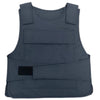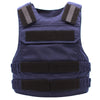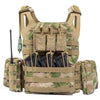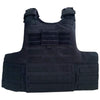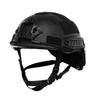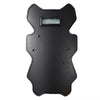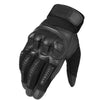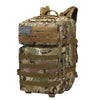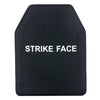
What are bulletproof vests made of?
7 min of reading
Are you interested in how bulletproof vests are made, but you have no idea what they are made of?
Today, the field of bulletproof vest brings together a large number of manufacturers all over the world. These companies constantly seek to offer the best quality in order to ensure optimal protection against various threats.
On the other hand, when it comes to weight, even a few hundred grams difference can make a difference. For this reason, manufacturers always try to make their vests lighter, while maintaining a high threshold of protection. If you want to know everything about these famous protective jackets, we strongly advise you to read our article. Here you will learn:
- The composition of bulletproof vests
- The different types of Kevlar
- Materials used in bulletproof vests
Let's get started without further ado!
What is the composition of bulletproof vests?
The materials used in making a bulletproof vest vary depending on the purpose for which it was designed. Thus, a bulletproof vest created for soldiers whose mission is to defend a point must be extremely resistant, even if it will be rather heavy.
Intervention soldiers , for their part, must wear vests that do not risk limiting their mobility. The latter must therefore be flexible and sufficiently light. Here, we'll take a look at the different types of body armor, focusing on their strengths and weaknesses.
Kevlar bulletproof vest
Kevlar was developed by DuPont de Nemours, which is an American group specializing in chemicals. The company is also known for creating the first Kevlar bulletproof vests. This material is a hydrocarbon fiber. It has unique characteristics that allow it to be both strong and light . It is also capable of resisting several types of attacks, including high-velocity impact and explosions. These traits allowed the DuPont de Nemours group to make revolutionary bulletproof vests.
Kevlar was invented by Stephanie Kwolek in 1964. Four years later, in 1970, DuPont de Nemours produced its first Kevlar bulletproof vests. It is also interesting to note that the success of these vests was mainly due to the fact that they were so thin that they were almost imperceptible under clothing. Towards the end of the 1980s, the research and development sector of DuPont de Nemours introduced the second generation of Kevlar, which it called Kevlar 129. The latter offered better protection against high-velocity bullets, such as those of the famous 9 mm FMJ.
In 1995, researchers discovered another type of Kevlar, which is correctional Kevlar . The latter is distinguished by its unique ability to resist blows from bladed weapons. It is for this reason that it was mainly used by law enforcement, unlike the military who favored vests which offered better resistance against large caliber bullets.
The DuPont group also created Protera kevlar in 1996. The company claims that this type of kevlar is of superior quality. Indeed, according to the manufacturer, this material has a unique molecular constitution, which explains its advantageous weight, its flexibility, and its optimal protection against bullets . In addition, thanks to technological advances and a modern manufacturing process, the strength and resistance of Protera kevlar have been improved.
Kevlar XP is one of the most recent models. Of course, the technology used in the creation of this type of Kevlar is patented in the name of DuPont. The latter offers no less than 15% additional resistance to deformation and is considerably stronger overall.
The material is present in bulletproof vests intended for troops who are often on the move, because it offers more comfort and the weight of one of its vests can weigh up to 1 kg less than a classic Kevlar vest . Furthermore, the S104 version of this Kevlar is significantly more practical underwater, which makes its vests particularly effective in tropical areas, where it rains most often.
The chemical composition of Kevlar body armor
Kevlar, by its scientific name: Poly-para-phenylene terephthalamide, has easily built an excellent reputation in global popular culture, notably thanks to Hollywood films and video games. That said, it is mainly gun enthusiasts who can judge it for its true value.
Indeed, thanks to this material, the survival rate of police officers and soldiers has increased tenfold in a short time. In addition, as we indicated above, these bulletproof vests are also lightweight and they are not likely to limit the agility of those who wear them. The success of Kevlar can be explained by three essential elements, which we explain to you here.
To understand the effectiveness of Kevlar, we must look at its technology, its chemical composition and the materials used in its manufacture:
Kevlar body armor technology
Protective Kevlar vests are created in such a way that they can stop bullets. They are even able to slow down large caliber projectiles, making them potentially less deadly. When designing, experts ensure that the vest can cover the maximum of the most likely and dangerous scenarios.
Also note that one of the most recent Kevlar technologies is that of liquid armor. This type of Kevlar is still in development and is only accessible by the US military, at the moment. It was created with the aim of offering the best protection while being particularly light and comfortable. In the field, such a vest clearly becomes a major advantage. Indeed, thanks to him, soldiers will be faster and more agile than ever.
The chemical elements found in Kevlar bulletproof vests
The chemical formula of Kevlar is: C14H14N204. The carboxylic group and the amino molecular group define the type of protection of the jacket. They therefore decide on its ability to absorb the shock, based on its weight.
If the Kevlar vest is so resistant, it is mainly due to its chemical composition and the way in which it is manufactured. The making therefore begins with a series of molecular threads, which constitute an entire surface when placed next to each other. This contact between the hydrogen molecules then generates a powerful bond which solidifies the material and allows it to withstand the most intense shocks. This explains why Kevlar is ten times more durable than steel.
Kevlar is essentially made of para-aramids. It is this material which allows it to be particularly flexible and which gives it the lightness that we know about it. The chemical makeup needed to make a Kevlar body armor consists of a carboxylic group and an amino molecular group which produce an AABB polymer formation. With sulfuric acid, we obtain a liquid which solidifies over time. The latter can be extracted in three different forms: in powder form, in fiber form, or in paste.
The different types of Kevlar
In total, there are three types of Kevlar protection in bulletproof vests:
- Ballistic protection (against bullets)
- Protection against knives
- Protection against all kinds of blunt objects
It is important to note that Kevlar ballistic protection is divided into two categories: so-called solid armor (which is capable of resisting large calibers) and light armor (which can only absorb small caliber bullets).
Likewise, there are two categories of Kevlar protection against knives and against blunt objects. These are the KR1 and KR2 for protection against knives and the KR1 / SP1 and KR2 / SP2 for blunt objects.
Essentially, body armor is designed to protect those who work in dangerous conditions, especially where crime is highest. For this reason, they must resist bullets as well as knife blows.
Since the creation of the very first protective armor, technology has never stopped evolving. With the advent of firearms, protective technology had no choice but to follow in order to limit damage. Modern bulletproof vests consist of a multitude of plates located all around the body, to offer optimal protection. The jacket must also be light enough to be worn for long hours and it is imperative that it is comfortable enough so as not to hamper the wearer's mobility.
The newest models feature a variety of ergonomic options that allow them to be even more reliable. They also include more protection, especially on the sides, where vests are often the most vulnerable. The fabric of body armor designed for use in warmer regions reduces heat absorption and prevents sweat penetration, limiting degradation of protective jackets.
Materials used in the best bulletproof vests
Not all newly designed body armor has to be of excellent quality. To find the best vests, consider looking for those made of the following materials:
The Spectra
Spectra protection was created by the Honeywell company in the United States. It is one of the best manufacturers of bulletproof vests in the world, since the company has been able to equip law enforcement as well as the country's military for more than two decades. The company is known for its ability to innovate. This is how it was able to develop the Spectra Shield 2, which is the superior version of the classic Spectra.
We can take the example of the Spectra SR-3124 armor, which is distinguished by its Spectra 3000 fiber. This is a complete suit, which includes the bulletproof vest and the helmet. On the other hand, the SA-3113 and SA-3118 armors are lightweight suits, but which offer good ballistic protection and optimal comfort for long trips. Furthermore, the SA-1211 armor is still in use at this time. It is distinguished by its exceptional ability to resist blunt objects and all kinds of bladed weapons.
The Gold Flex
It is also a material developed by the Honeywell company. It is made up of several synthetic fibers and is often found in ballistic vests. AlliedSignal, which is the group which bought HoneyWell and which subsequently took its name again, was the first to have used the same technology to create another material and which is none other than Gold Shield.
Today, there are exactly three types of plates:
- The Gold Shield: it is created using aramid fibers instead of Spectra fibers
- Gold Shield PCR: usable in the most resistant vests and helmets
- GoldFlex: usable in tactical bulletproof vests
Dyneema
Dyneema is an extremely popular fiber with ballistic vest manufacturers. Unlike most sophisticated materials found in high-end protective jackets, this one was discovered by pure chance. This was in 1963, when Ron Koningsveld and Albert Pennings were experimenting with crystallization to rearrange polyethylene molecules. This experiment therefore allowed them to crystallize the polyethylene by mixing it rather than cooling it.
So ! Now you know everything you need to know about the construction of bulletproof vests. You will therefore be able to choose the one you need, depending on your objectives and on the basis of the materials that offer the most safety and comfort.
At Tactic Delta , we offer numerous collections of high quality Bulletproof Vests , and other protective equipment, including Ballistic Plates . If you want to best complement your combat equipment, you can perfectly obtain our Bulletproof Vest for Individuals !
Up to you !

